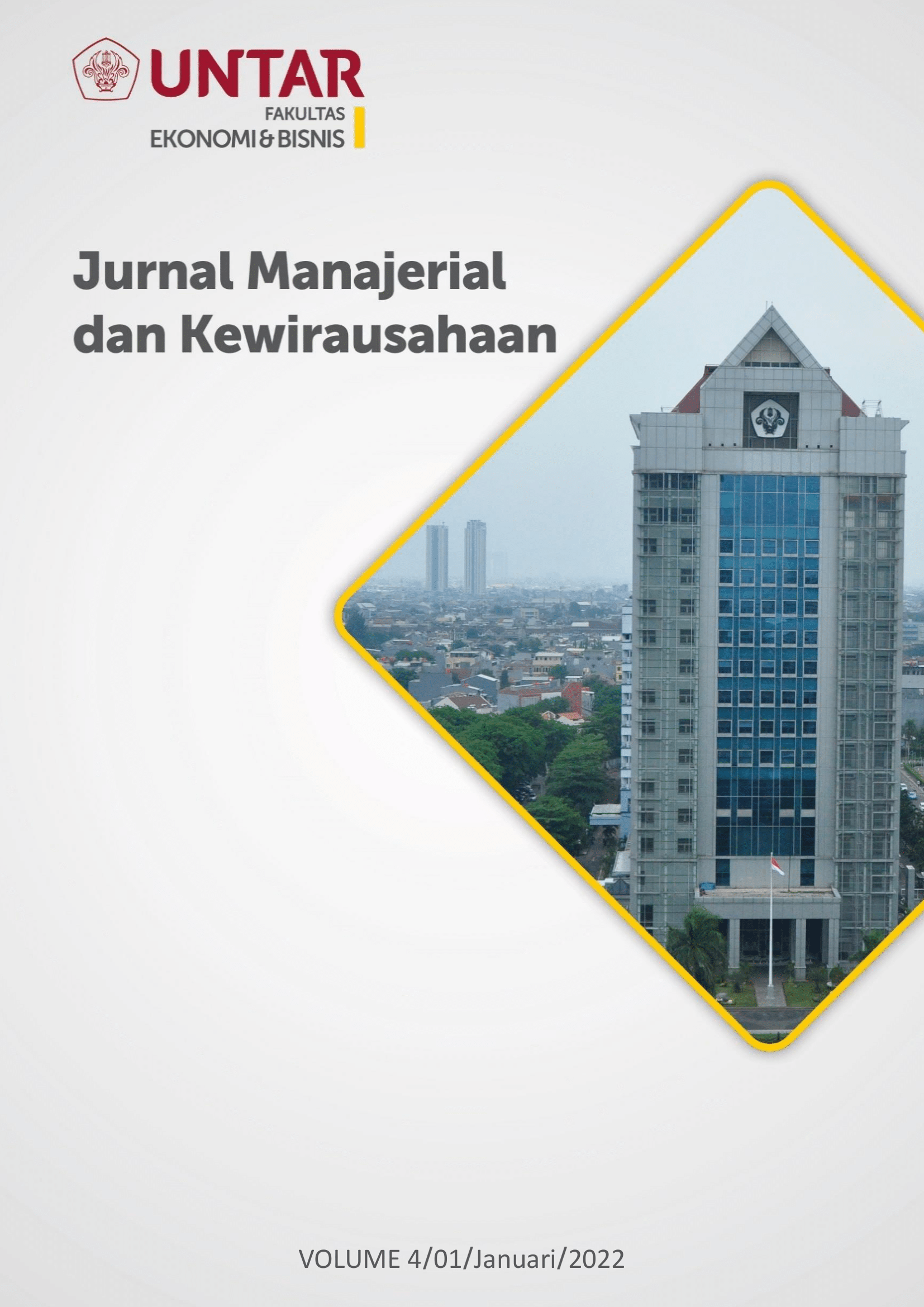Variabel yang Memprediksi Intention to Use Brand E-Payment di Jakarta
Main Article Content
Abstract
Penelitian ini bertujuan untuk mengkaji mengenai prediksi trust, perceived usefulness, dan perceived ease of use terhadap intention to use e-payment di Jakarta. Unified Theory of Acceptance dan Use of Technology (UTAUT) menjadi dasar dari penelitian ini, dimana teori tersebut menggambarkan bahwa terdapat hubungan antara penerimaan produk dan kepercayaan pengguna yang kemudian menjadi nilai yang penting bagi perusahaan e-payment. Penelitian ini merupakan penelitian deskriptif dengan pendekatan cross-sectional design. Pengumpulan sampel dilakukan dengan metode non-probability sampling dengan teknik convenience sampling. Data yang dikumpulkan dan kemudian dianalisis untuk menjawab hipotesis penelitan sebanyak 170 responden yang sudah pernah menggunakan e-payment untuk melakukan transaksi. Hasil penelitian ini menunjukkan bahwa trust dan perceived usefulness dapat memprediksi intention to use secara positif dan siginfikan, sedangkan perceived ease of use tidak dapat digunakan untuk memprediksi intention to use secara signifikan.
This study aims to examine the predictions of trust, perceived usefulness, and perceived ease of use on the intention to use e-payment in Jakarta. The Unified Theory of Acceptance and Use of Technology (UTAUT) is the basis of this research, whereas the theory illustrates that there is a relationship between product acceptance and user trust which then becomes an important value for e-payment companies. This research is a descriptive study with a cross-sectional design approach. The sample was collected using a non-probability sampling method with a convenience sampling technique. Data were collected and then analyzed to answer the research hypothesis as many as 170 respondents who had used e-payments to make transactions. The results of this study indicate that trust and perceived usefulness can predict intention to use positively and significantly, while perceived ease of use cannot be used to predict intention to use significantly.
Article Details
Section
This work is licensed under a Jurnal Muara Ilmu Ekonomi dan Bisnis Creative Commons Attribution-ShareAlike 4.0 International License.,/p>
References
Chiu, C. M., & Wang, E. T. G. (2008). Understanding Web-based learning continuance intention: The role of subjective task value. Information and Management, 45(3), 194–201. https://doi.org/10.1016/j.im.2008.02.003
Davis, F. D. (1989). Perceived usefulness, perceived ease of use, and user acceptance of information technology. MIS Quarterly: Management Information Systems, 13(3), 319–339. https://doi.org/10.2307/249008
Davis, F. D., Bagozzi, R. P., & Warshaw, P. R. (1989). User Acceptance of Computer Technology: A Comparison of Two Theoretical Models. Management Science, 35(8), 982–1003. https://doi.org/10.1287/mnsc.35.8.982
Gefen, D., Karahanna, E., & Straub, D. W. (2003). Trust and TAM in online shopping: an integrated model. MIS Quarterly, 27(1), 51–90. https://doi.org/10.2307/30036519
Gu, J. C., Lee, S. C., & Suh, Y. H. (2009). Determinants of behavioral intention to mobile banking. Expert Systems with Applications, 36(9), 11605–11616. https://doi.org/10.1016/j.eswa.2009.03.024
Hendro, & Keni. (2020). eWOM dan Trust sebagai Prediktor terhadap Purchase Intention: Brand Image sebagai Variabel Mediasi. Jurnal Komunikasi, 12(2), 298–310. https://doi.org/10.24912/jk.v12i2.7760
Ismail, H. A. (2016). Intention to Use Smartphone through Perceived Compatibility, Perceived Usefulness, and Perceived Ease of Use. Jurnal Dinamika Manajemen, 7(1), 1–10. https://doi.org/10.15294/jdm.v7i1.5748
Keni, K. (2020). How Perceived Usefulness and Perceived Ease of Use Affecting Intent to Repurchase? Jurnal Manajemen, 24(3), 481–496. http://dx.doi.org/10.24912/jm.v24i3.680
Kim, C., Mirusmonov, M., & Lee, I. (2010). An empirical examination of factors influencing the intention to use mobile payment. Computers in Human Behavior, 26(3), 310–322. https://doi.org/10.1016/j.chb.2009.10.013
Lee, C. B. P., & Wan, G. (2010). Including Subjective Norm and Technology Trust in the Technology Acceptance Model: A Case of E-Ticketing in China. Data Base for Advances in Information Systems, 41(4), 40–51. https://doi.org/10.1145/1899639.1899642
Luarn, P., & Lin, H. H. (2005). Toward an understanding of the behavioral intention to use mobile banking. Computers in Human Behavior, 21(6), 873–891. https://doi.org/10.1016/j.chb.2004.03.003
Malhotra, N. K. (2014). Basic Marketing Research. Pearson.
Mcknight, D. H., Choudhury, V., & Kacmar, C. (2002). Developing And Validating Trust Measure for E-Commerce: An Integrative Typology. Information Systems Research, 13(3), 334–359. https://doi.org/10.1287/isre.13.3.334.81
Monsuwe, T. P., Dellaert, B. G., & De Ruyter, K. (2004). What drives consumers to shop online? A literature review. International Journal of Service Industry Management, 15(1), 102–121. https://doi.org/10.1108/09564230410523358
Pavlou, P. A. (2003). Consumer acceptance of electronic commerce: Integrating trust and risk with the technology acceptance model. International Journal of Electronic Commerce, 7(3), 101–134. https://doi.org/10.1080/10864415.2003.11044275
Rokhman, A. (2011). E-Government Adoption in Developing Countries; the Case of Indonesia. Journal of Emerging Trends in Computing and Information Sciences, 2(5), 228–236.
Rotchanakitumnuai, S., & Speece, M. (2009). Modeling electronic service acceptance of an e?securities trading system. Industrial Management & Data Systems, 109(8), 1069–1084. https://doi.org/10.1108/02635570910991300
Sun, S., Goh, T., Fam, K. S., & Xue, Y. (2012). The influence of religion on Islamic mobile phone banking services adoption. Journal of Islamic Marketing, 3(1), 81–98. https://doi.org/10.1108/17590831211206617
Venkatesh, V., & Morris, M. G. (2000). Why Don’t Men Ever Stop to Ask for Directions? Gender, Social Influence, and Their Role in Technology Acceptance and Usage Behavior. Management Information Systems Research Center, 24(1), 115–139. https://doi.org/10.2307/3250981
Venkatesh, V., Thong, J. Y. L., & Xu, X. (2016). Unified theory of acceptance and use of technology: A synthesis and the road ahead. Journal of the Association for Information Systems, 17(5), 328–376. https://doi.org/10.17705/1jais.00428

